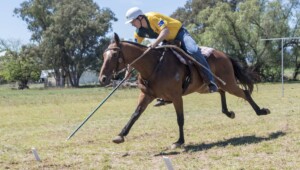While it’s not clear where the equestrian sport of tent pegging originated, it has been documented as a sport as early the fourth century BC. It is practiced on horseback with the rider using either a lance or a sword and the modern sport originally evolved from Calvary training.
Soldiers on horseback were trained to conduct pre-dawn raids on enemy camps and remove the tent pegs from the tents in which their enemies were sleeping, using the tips of their sharp swords as they galloped past. Soldiers on foot would then attack their enemy as they tried to escape their collapsing tents hence the name tent pegging. Nowadays the art of tent pegging has evolved so that the rider must use the sword or lance to pick up and carry away small objects including tent pegs that are placed on the ground by piercing and carrying them away. To this day light horse and mounted police participate in tent pegging displays to show off their horsemanship and riding skills.
During 1982 the Olympic Council of Asia accepted tent pegging as an official sport and allowed it in the New Delhi Asian Games. Since then more countries have recognised the sport and it has its own international events in South Africa, Namibia, India, Pakistan, Israel, Great Britain, Netherlands, USA, Canada, and New Zealand.
Scoring for tent pegging is as follows:
· Carry 6 points Six points are scored when you carry your peg at least 20 meters
· Draw 4 points Four points are scored when the peg is drawn out of the grown but not carried the 20 meters.
· Strike 2 points Two points are scored when the peg is not drawn from the ground but there is a weapon strike to the peg.
Off shoot sports of tent penning include: Pair of lances Two riders run two abreast past two pegs that are in the ground. Each rider is to draw their own peg from the ground with their lance. The pair then halt at the other end and walk across to the next track where a judge signals for them to repeat the exercise. Points are given for the pegs as well as for drill. This can also be ridden as a team with four riders (also known as a team).
Pair of swords This is the same as a pair of lances except that a sword is used instead. Two riders run two abreast past two pegs that are in the ground. Each rider is to draw their own peg from the ground with their sword. The pair then halt at the other end andwalk across to the next track where a judge signals for them to repeat the exercise. Points are given for the pegs as well as for drill. This can also be ridden as a team with four riders (also known as a team).
Rings and peg A ring with a width of six centimetres is suspended from a gallow with suspender strap at a height of 2.2 meters from the ground. Two gallows are placed 15 meters apart in a straight line with a peg 20 meters beyond the second gallow. A rider using a lance and at the gallop must bring the lance to a position above the arm and collect both rings and a peg in the ground. This sport can also take place with a sword where the rider cuts the ring string and collects the tent peg on the end of their weapon.
Australia has a very active tent pegging community where tent pegging and its offshoot games are competed at organised events as well as at
agricultural shows and gymkhana / sporting games. The Australian Tent pegging Association was formed in 1981 to facilitate and oversee all tent pegging activities in Australi




